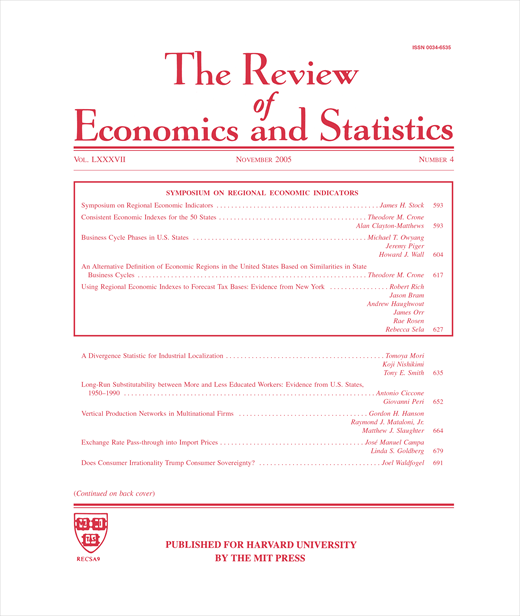Entrepreneurship, Innovation, and Productivity Growth
The research group “Entrepreneurship, Innovation, and Productivity Growth” tackles a broad set of research topics that are of relevance for our understanding of patterns of innovation and productivity growth and explores implications for workers and firms. Areas of particular focus include the decline in business dynamism, the growth in automation, entrepreneurship and innovation, and supply chains. The work is empirical in focus, it is grounded in microeconomic data research, but seeks to understand relevant macroeconomic trends.
Workpackage 1: Business Dynamism
The last decade has seen the explosion of research on business dynamism largely as a result of the development of new comprehensive firm and establishment level micro datasets. In this workpackage we exploit existing CompNet data to understand patterns of business dynamism in Europe.
In particular this subgroup seeks to explain the role of technological change and market power. The team documents the decline in young firm activity and reallocation, and estimates models that assess the causes and impacts on productivity growth (with Matthias Mertens, Sergio Inferrara, and Filippo Biondi).
Workpackage 2: Entrepreneurship
Going back to the days of Schumpeter, economists understand the important role entrepreneurs play in modern capitalist economies. This workpackage sets up a collaboration with the ZEW to develop a new data infrastructure and explore entrepreneurship in Germany broadly. Areas of research include:
a. Entrepreneurship and Firm Performance: Understanding High Growth Firms.
b. Innovative Firms and the Diffusion of Technology
c. (Im)Migration, Entrepreneurship and Regional Development
Workpackage 3: Automation
The introduction of robots and automation technologies in the workplace are fundamentally altering the balance of tasks and skills that are in demand. At the same time automation technologies increase the productivity of the workers and firms that make use of them relative to those that do not and can potentially lead to winners and losers. In this workpackage we conduct research on robot automation and its impacts on workers and firms. We focus our research both in Germany and the U.S..
The research group makes use of various administrative and survey datasets from a variety of sources and countries.
IWH Data Project: CompNet Database
The Competitiveness Research Network (CompNet) is a research network founded in 2012 to foster the debate on competitiveness issues among partner institutions and researchers. It aims at providing a robust theoretical and empirical link between micro-level drivers of competitiveness and macroeconomic performance for research and policy analysis purposes.
CompNet is funded by various European institutions, including among others: European Bank of Reconstruction and Development (EBRD); European Central Bank (ECB); European Commission (EC); European Investment Bank (EIB); European Stability Mechanism (ESM); France Stratégie; German Council of Economic Experts, Halle Institute for Economic Research (IWH); German Federal Ministry of Economic Affairs and Climate Action (BMWK); Tinbergen Institute (TI). CompNet is advised by leading researchers in the field of firm performance and has created a European micro-aggregated industry- and country-level database on indicators of firm- and country-level competitiveness and performance.
The database is unique in terms of its coverage and contents, particularly as, although being aggregated, it contains rich information on firm heterogeneity (i.e., distributional characteristics, like standard deviations and various percentiles of the firm distributions) across a large set of countries and industries in Europe. Among others, key variables included in the database are indicators of firm productivity, market power, firms’ financial situation, trade, and firm dynamics.
Research Cluster
Productivity and InstitutionsYour contact

- Department Centre for Business and Productivity Dynamics, Cbpd
Refereed Publications

The Role of Entrepreneurship in US Job Creation and Economic Dynamism
in: Journal of Economic Perspectives, No. 3, 2014
Abstract
An optimal pace of business dynamics—encompassing the processes of entry, exit, expansion, and contraction—would balance the benefits of productivity and economic growth against the costs to firms and workers associated with reallocation of productive resources. It is difficult to prescribe what the optimal pace should be, but evidence accumulating from multiple datasets and methodologies suggests that the rate of business startups and the pace of employment dynamism in the US economy has fallen over recent decades and that this downward trend accelerated after 2000. A critical factor in accounting for the decline in business dynamics is a lower rate of business startups and the related decreasing role of dynamic young businesses in the economy. For example, the share of US employment accounted for by young firms has declined by almost 30 percent over the last 30 years. These trends suggest that incentives for entrepreneurs to start new firms in the United States have diminished over time. We do not identify all the factors underlying these trends in this paper but offer some clues based on the empirical patterns for specific sectors and geographic regions.

How Firms Respond to Business Cycles: The Role of Firm Age and Firm Size
in: IMF Economic Review, No. 3, 2013
Abstract
There remains considerable debate in the theoretical and empirical literature about the differences in the cyclical dynamics of firms by firm size. This paper contributes to the debate in two ways. First, the key distinction between firm size and firm age is introduced. The evidence presented in this paper shows that young businesses (that are typically small) exhibit very different cyclical dynamics than small/older businesses. The second contribution is to present evidence and explore explanations for the finding that young/small businesses were hit especially hard in the Great Recession. The collapse in housing prices accounts for a significant part of the large decline of young/small businesses in the Great Recession.

Who Creates Jobs? Small versus Large versus Young
in: Review of Economics and Statistics, No. 2, 2013
Abstract
The view that small businesses create the most jobs remains appealing to policymakers and small business advocates. Using data from the Census Bureau's Business Dynamics Statistics and Longitudinal Business Database, we explore the many issues at the core of this ongoing debate. We find that the relationship between firm size and employment growth is sensitive to these issues. However, our main finding is that once we control for firm age, there is no systematic relationship between firm size and growth. Our findings highlight the important role of business start-ups and young businesses in U.S. job creation.

Towards Unrestricted Public Use Business Microdata: The Synthetic Longitudinal Business Database
in: International Statistical Review, No. 3, 2011
Abstract
In most countries, national statistical agencies do not release establishment-level business microdata, because doing so represents too large a risk to establishments’ confidentiality. One approach with the potential for overcoming these risks is to release synthetic data; that is, the released establishment data are simulated from statistical models designed to mimic the distributions of the underlying real microdata. In this article, we describe an application of this strategy to create a public use file for the Longitudinal Business Database, an annual economic census of establishments in the United States comprising more than 20 million records dating back to 1976. The U.S. Bureau of the Census and the Internal Revenue Service recently approved the release of these synthetic microdata for public use, making the synthetic Longitudinal Business Database the first-ever business microdata set publicly released in the United States. We describe how we created the synthetic data, evaluated analytical validity, and assessed disclosure risk.

Business Volatility, Job Destruction, and Unemployment
in: American Economic Journal: Macroeconomics, No. 2, 2010
Abstract
Unemployment inflows fell from 4 percent of employment per month in the early 1980s to 2 percent by the mid 1990s. Using low frequency movements in industry-level data, we estimate that a 1 percentage point drop in the quarterly job destruction rate lowers the monthly unemployment inflow rate by 0.28 points. By our estimates, declines in job destruction intensity account for 28 (55) percent of the fall in unemployment inflows from 1982 (1990) to 2005. Slower job destruction accounts for similar fractions of long-term declines in the rate of unemployment.
Working Papers

Measuring the Impact of Household Innovation using Administrative Data
in: NBER Working Paper, No. 25259, 2018
Abstract
We link USPTO patent data to U.S. Census Bureau administrative records on individuals and firms. The combined dataset provides us with a directory of patenting household inventors as well as a time-series directory of self-employed businesses tied to household innovations. We describe the characteristics of household inventors by race, age, gender and U.S. origin, as well as the types of patented innovations pursued by these inventors. Business data allows us to highlight how patents shape the early life-cycle dynamics of nonemployer businesses. We find household innovators are disproportionately U.S. born, white and their age distribution has thicker tails relative to business innovators. Data shows there is a deficit of female and black inventors. Household inventors tend to work in consumer product areas compared to traditional business patents. While patented household innovations do not have the same impact of business innovations their uniqueness and impact remains surprisingly high. Back of the envelope calculations suggest patented household innovations granted between 2000 and 2011 might generate $5.0B in revenue (2000 dollars).













